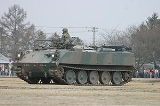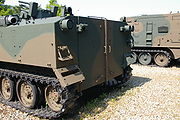
Type 73 Armored Personnel Carrier
Encyclopedia
The is an armored personnel carrier that entered service with Japan Ground Self-Defense Force
in 1973.
and Mitsubishi Heavy Industries
each built two prototypes the following year, one each in steel and aluminium. Mitsubishi's aluminium model was chosen for use in December 1973.

, its companion Type 75 wind measurement vehicle and the Type 74 105 mm Self-propelled howitzer
.
that 337 Type 73s were in service, although it seems unlikely to be fully superseded due to the Type 89
's slow production rate.
Japan Ground Self-Defense Force
The , or JGSDF, is the army of Japan. The largest of the three services of the Japan Self-Defense Forces, the Ground Self-Defense Force operates under the command of the chief of the ground staff, based in the city of Ichigaya, Tokyo. The present chief of ground staff is General Yoshifumi Hibako...
in 1973.
Development
The Japanese Defense Agency's Technical Research and Development Institution issued a requirement for a new APC to replace the Type SU 60 in 1967. Among the requirements included a maximum speed of over 60 km/h, ability to carry 12 men including the crew, to be fully amphibious, have all-welded aluminium armor, provision for the infantry to use their small arms from inside the vehicle and be armed with a 20 mm cannon, a 12.7 mm machine gun and a 7.62 mm machine gun. An automotive test rig, called the SUT, was built in 1968. KomatsuKomatsu
orKomatsu is a multinational corporation that manufactures construction, mining, and military equipment, Industrial equipments such as press machines, lasers, and thermoelectric generators.Its headquarters is at 2-3-6, Akasaka, Minato, Tokyo, Japan...
and Mitsubishi Heavy Industries
Mitsubishi Heavy Industries
, or MHI, is a Japanese company. It is one of the core companies of Mitsubishi Group.-History:In 1870 Yataro Iwasaki, the founder of Mitsubishi took a lease of Government-owned Nagasaki Shipyard. He named it Nagasaki Shipyard & Machinery Works, and started the shipbuilding business on a full scale...
each built two prototypes the following year, one each in steel and aluminium. Mitsubishi's aluminium model was chosen for use in December 1973.
Description
The Type 73 is almost unique in that it uses a mid-engined layout, as the driver and bow machine gunner are in the front of the vehicle. The commander sits slightly behind the bow gunner while the gunner sits behind the driver. The engine is mounted on the left side behind the bow gunner with both its air intake and exhaust on the top of the vehicle. The engine and transmission are designed to be easily removed as one complete unit. The gunner's cupola can traverse a full 360°, but the bow gunner's weapon can only traverse, elevate and depress 30°. It is fitted with six smoke dischargers, three on each side. Its infantry can fire their personal weapons from inside the vehicle. The Type 73 requires additional equipment to become amphibious and is propelled through the water by its tracks at a maximum speed of 7 kilometres per hour (4.3 mph). It is fitted with infra-red driving lights and an NBC system.
Variants
A command version is in service with a raised roof. The Type 73's chassis served has been adapted for use by the Type 75 130 mm Multiple Rocket LauncherType 75 130 mm Multiple Rocket Launcher
The was developed to carry the 130 mm rocket system developed by the Aerospace Division of the Nissan Motor Company. It used the suspension, tracks and diesel engine of the Type 73 Armored Personnel Carrier. Komatsu was responsible for the chassis and IHI Aerospace, as Nissan's Aerospace...
, its companion Type 75 wind measurement vehicle and the Type 74 105 mm Self-propelled howitzer
Type 74 105 mm Self-propelled howitzer
The Type 74 105 mm self-propelled howitzer is only used by Japan. It shares a number of automotive components with the Type 73 Armored Personnel Carrier which was developed during the same time. Komatsu developed the chassis, while the howitzer and turret were designed by Japan Steel Works. The...
.
Status
As of 2001, Japan reported to the United Nations Office for Disarmament AffairsUnited Nations Office for Disarmament Affairs
The UN Office for Disarmament Affairs is a department of the United Nations Secretariat established in January 1998 as the Department for Disarmament Affairs as part of the United Nations Secretary-General Kofi Annan's plan to reform the UN as presented in his report to the General Assembly in...
that 337 Type 73s were in service, although it seems unlikely to be fully superseded due to the Type 89
Mitsubishi Type 89 IFV
The is a Japanese infantry fighting vehicle that entered service with the Japan Ground Self-Defense Force in 1989. The vehicle was adopted at a low rate with 58 vehicles in service , with a total of 70 produced by 2005...
's slow production rate.

